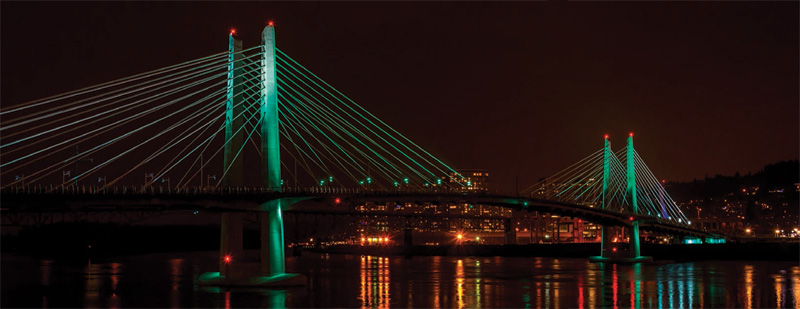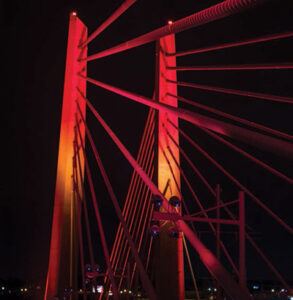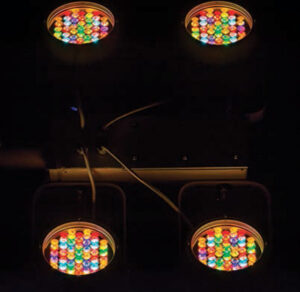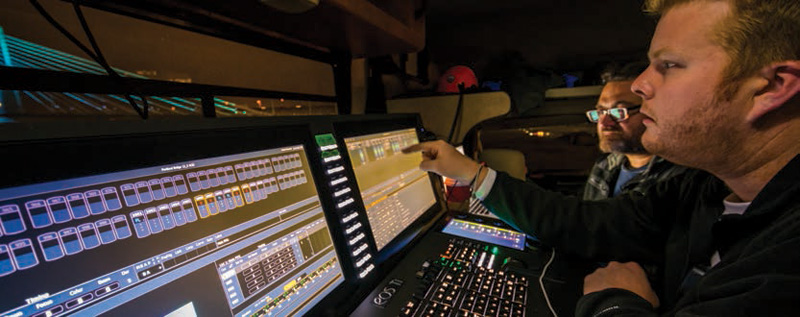The illumination of Tilikum Crossing in Portland, OR, is a metaphor for a conversation between a river and a bridge. Controls provide the translation

By Bridget Mintz Testa
Imagine a conversation between a bridge and the river that flows beneath it. Now imagine that conversation was made visible. What would it look like? What topics would it cover? Would it glow brilliantly, like the lights of Las Vegas, or would it subtly gleam, like clouds backlit by the sun?
These questions came to the forefront during the construction of Tilikum Crossing—the Bridge of the People—in Portland, OR. The first bridge to be built in the city since 1973, Tilikum Crossing links the bustling, growing west and east sides of Portland across the Willamette River. The 1,780-ft long cable-stayed bridge was always envisioned as more than just a means for light rail, buses, pedestrians and cyclists—but not automobiles or commercial traffic—to cross the Willamette. It was, from the start, also intended to be a work of art.
Addressing the four major challenges needed to realize that goal, however, took all six years of the bridge’s construction from preliminary engineering to opening day.
The first challenge was determining the artistic aspect of the bridge. Husband-and-wife artistic team Douglas Hollis and Anna Valentina Murch (Murch passed away midway through the project) was hired in 2009-2010 at the same time that Donald MacDonald was named as the bridge’s architect and Semyon Treyger and the Seattle office of his firm, HNTB, were selected as structural engineers.
“It is rare to hire everyone at the same time,” says Robert Hastings, the architect with Portland’s TriMet Transit Authority, who managed the architectural design aspects of the bridge. “Artists are usually called in towards the end, but we wanted the artists to hear what MacDonald and Treyger were planning so that they could all influence each other.”
In their conversations with the architect and structural engineer, Hollis and Murch learned how important different physical variables of the river were to the engineering and architecture of the bridge. “They decided that would be their artistic vision—how the bridge reacted to the physical variables,” Hastings says. “Doug and Anna’s job was to manifest those in a public way that would illustrate them so the public would know what was happening to the river.”
Hollis describes himself and Murch, both longtime public artists, as “environmental sculptors.” “For many years, we worked with natural elements such as wind and water. We try to use them as sculptural elements. The primary core of our concept for Tilikum Crossing was a conversation between a river and a bridge.” The crucial artistic question was what that conversation would actually look like. “Early on, Anna and Doug began creating illustrations showing the bridge at night,” Hastings says. “There were drawings and an early computer rendering of the dynamic quality of the light. It was like looking at the Northern Lights.” Subsequently, “We believed their vision would be very appropriate. It was not bright like Las Vegas; instead, it would show Portland’s sensitivity to the environment.”
DIALOGUE TAKES SHAPE

With this vision in mind, the next challenge was obtaining the right fixtures. Murch and Hollis began looking for programmable multi-color LEDs that would realize their vision. The first fixtures selected didn’t meet the strict “buy American” requirement for the bridge.
Karl Haas of ETC, Inc., the company that would design the “made-in-America” control system, proposed the company’s multi-chip seven-color D40 LED luminaire. He demonstrated it to Murch, and she approved it.
The third challenge was to validate the luminaires’ use for lighting the bridge’s cable stays and pylons. Sample fixtures were obtained from ETC in 2013, two years into bridge construction. Tests were conducted to see if the fixtures had a long enough beam throw and enough color options. They did.
But that was just the beginning of the testing of the luminaires. They had to be able to light up both the cables and the pylons of the bridge. Modern cables are enclosed in PVC pipe for weather protection. This is fortunate because PVC pipe has a rough surface, and its electromagnetic properties are well-known. “The light on a rough surface glows,” says Bert Klawa, an electrical engineer with Reyes Engineering in Portland, who performed all the testing and did all the calculations for the fixtures. “A polished mirror surface doesn’t light up.”
It was also necessary to determine the luminaires’ beam brightness to calculate how many of them would be needed. Existing lighting software wasn’t sufficient for this step. Instead, Klawa used electromagnetic calculations to measure the light. “We knew how PVC reacted to electromagnetic fields,” he says. “We used that information—data from radar and radio performance—to analyze how the light reacted when intersecting the PVC pipe at angles tangential to the pipe—the light beam was intersecting the pipe almost parallel to it.” Using the known permeability and permittivity of PVC, Klawa calculated the reflectance of the pipe. Those calculations “proved that we could make it work,” he says. The calculations also showed that 178 luminaires would be needed.
There are five poles for each cable stay for a total of 40 poles. Each pole has fixtures mounted on support brackets. Shorter cable stays are illuminated by two fixtures, medium-length cable stays require three fixtures and the longest cable stays require four fixtures. It proved necessary to add fixtures as the cable stays got longer to achieve uniform brightness across the whole bridge. For their work on Tilikum Crossing, Reyes Engineering received a 2016 IES Illumination Award of Merit.
“The luminaires were just bright enough for the light level to be right,” Klawa adds. Each luminaire emits 2,680 field lumens with all LED emitters on. “It’s pleasant,” Klawa notes, “but it doesn’t look like carnival lighting. TriMet wanted the bridge to be iconic, but not carnival-bright.”
Obtaining the ETC D40 fixtures required an increase in the bridge budget, but with the made-in-America documentation, the additional funds were forthcoming. Manufacturing began in ETC’s Middleton, WI, factory in February 2014.
DATA DRIVES DESIGN

The fourth and biggest challenge was integrating and orchestrating data, programming and lighting to illuminate the bridge. Data comes from a U.S. Geological Survey monitor that measures variables such as the temperature of the river, tidal action, velocity of the water, river gauge height (how high the river is at a certain point, and the discharge rate or volume of water passing a certain point. The monitor can be accessed wirelessly, and its data is online. That data is the basis of the conversation between the river and the bridge.
Digital artist and programmer Morgan Barnardused Max MSP software to create the program for the light of the river-bridge conversation. River temperature is linked to light color. For example, when the river temperature is 77 deg F, the primary light color is orange, the secondary color is red and the accent color is green. When the river temperature is 58 deg, the primary light color is minty green, the secondary color is light green and the accent color is turquoise. When the river temperature is 41 deg, the primary color is deep blue, the secondary color is turquoise and the accent color is purple.
Tidal changes control the speed at which the light changes, while the velocity of the river water controls the movement of the primary color gradations. River gauge height controls contrast in the primary color patterns to enhance an appearance of movement. “When the gauge height is high, we have more broken-up color; when the gauge height is low, we will have less broken-up color,” Barnard says. The river’s discharge rate controls the speed of a stripe accent in the light patterns.
Barnard’s program translates environmental data points into numeric values that are shared with the ETC Ion remote processing unit via UDP protocol. The Ion RPU “lives in a rack in a TriMet control room which is in a vault adjacent to the bridge,” notes lighting and media programmer Trevor Burk, who worked with Barnard to execute the control system and achieve the artistic vision of Hollis and Murch. “The console is set up so that the incoming UDP commands can drive the pixel map engine to create evolutions of different light, movement and texture so you never get the same image twice. The idea is that you get a lot more organic nature and you have more flexibility in the lighting elements’ overlay on each other.”
Hollis and Murch didn’t want static lighting. “We wanted a sense of motion,” Hollis says. “The lights are static, but dimmable. By fading up and down, you get a sense of motion on the bridge. We just played with the colors and the mixing of them. The colors go from deep red to deep blue, a rich red up through orange and amber. The deep blue goes to light blue, dark greens and then light greens—it’s a continuous spectrum.” A live feed of the bridge is always available at www.allclassical.org/tilicam/.

The bridge also has transitway LED lighting, which is controlled with a non-dimmable, photo-cell “on” and “off” exterior lighting system. The transitway lighting of the east and west halves of the bridge are synchronized through a central digital controller which provides uniform illumination along the total length of the bridge between dusk and dawn.
Tilikum Crossing officially opened to the public in a night-time celebration named “First Light” on September 10, 2015. For that one event, the lights of the bridge moved in synchrony with music played by the radio station, All Classical Portland. On that evening, Barnard controlled the lights live in concert with the music to show the full range of colors.
Ultimately, the Willamette River flows and changes temperature, rises or drops in height, and all of these changes influence the lighting, making it seem as if the bridge is slowly breathing in and out in color as it and the river carry on a continuing conversation.

